I and the Bird #22
 Don't miss today's bird carnival, hosted by Home Bird Notes. HomeBird takes us on a delightful journey from her home in south Jersey around the world.
Don't miss today's bird carnival, hosted by Home Bird Notes. HomeBird takes us on a delightful journey from her home in south Jersey around the world.
tidbits about birds, birders and birding from WildBird's editor
 Don't miss today's bird carnival, hosted by Home Bird Notes. HomeBird takes us on a delightful journey from her home in south Jersey around the world.
Don't miss today's bird carnival, hosted by Home Bird Notes. HomeBird takes us on a delightful journey from her home in south Jersey around the world.
 We want to know what birders of all skills think of various backyard products, binoculars, spotting scopes, printed media, activities, destinations and online/digital/audio media.
We want to know what birders of all skills think of various backyard products, binoculars, spotting scopes, printed media, activities, destinations and online/digital/audio media. It is possible, however, for you to disqualify your entries; the rules appear on page 59.
It is possible, however, for you to disqualify your entries; the rules appear on page 59.


 So, if you have an opinion... and don't we all... here's your chance to share it and win a fantastic prize.
So, if you have an opinion... and don't we all... here's your chance to share it and win a fantastic prize. Scientists at the University of California at San Diego say a non-native species that's usually vilified by birders recognizes grammar in birdsong. The study will appear in Nature on Thursday.
Scientists at the University of California at San Diego say a non-native species that's usually vilified by birders recognizes grammar in birdsong. The study will appear in Nature on Thursday.The European starling, a tiny virtuoso, has the ability to learn and recognize a feature of grammar that has long been thought to be unique to human languages, researchers report in a new study. ...Will this improve starlings' popularity among birders?
"Our research is a refutation of the canonical position that what makes human language unique is a singular ability to comprehend these kinds of patterns," said the leader of the new study, Timothy Gentner of the University of California at San Diego.
 Phone calls yesterday failed to elicit responses -- which isn't surprising, given their task of covering the entire state of Texas in five days and identifying the most species. I don't anticipate talking to them until about midnight on Saturday, when the guys will turn in their team checklist for the judges' reviews. If the Nikon WildBirders win the weeklong tournament, they'll receive bragging rights for a year and the chance to donate $20,000 to a habitat conservation project in Texas, as previous WildBird teams have.
Phone calls yesterday failed to elicit responses -- which isn't surprising, given their task of covering the entire state of Texas in five days and identifying the most species. I don't anticipate talking to them until about midnight on Saturday, when the guys will turn in their team checklist for the judges' reviews. If the Nikon WildBirders win the weeklong tournament, they'll receive bragging rights for a year and the chance to donate $20,000 to a habitat conservation project in Texas, as previous WildBird teams have.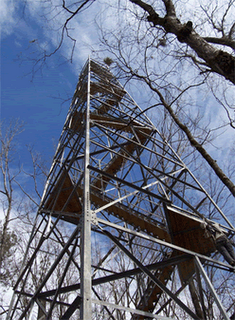 Want to climb a 100-foot canopy tower without flying to Panama? Head to Alabama, and try out the new tower at Perry Lakes Park. Constructed by Auburn University's School of Architecture Rural Studio program, the facility near Marion (east of Montgomery) opened last weekend after a four-year effort by architecture students.
Want to climb a 100-foot canopy tower without flying to Panama? Head to Alabama, and try out the new tower at Perry Lakes Park. Constructed by Auburn University's School of Architecture Rural Studio program, the facility near Marion (east of Montgomery) opened last weekend after a four-year effort by architecture students.the objective for the canopy tower is to create an opportunity for the underserved community in the southern united states to participate in one of the fastest growing sports, birding. participation in the sport of birding increased 235% from 1982 to 2000. the canopy tower will enable birders to access heights not previously available in the past. sport participation and education for local children and families will result from the new viewing opportunities.The link above leads to details and photographs about the students' work on the boardwalk and the canopy tower, a recycled fire tower donated by the Alabama Forestry Commission. Could this idea lead to more birding towers in North America?
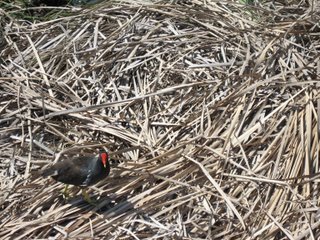 Do you revel in photos of birds? Even if you don't take pictures of birds in your back yard or in the field, you might enjoy perusing some of the 3,368 Flickr photo groups that use a bird "tag", such as Bird Fanatics!, Birds of Prey, Bird Identification help book or Birds in Flight.
Do you revel in photos of birds? Even if you don't take pictures of birds in your back yard or in the field, you might enjoy perusing some of the 3,368 Flickr photo groups that use a bird "tag", such as Bird Fanatics!, Birds of Prey, Bird Identification help book or Birds in Flight.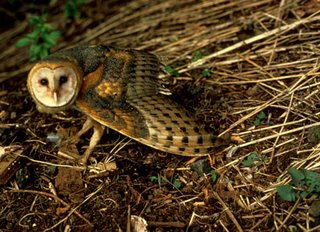 The Bay Area bastion of liberalism recently adopted Barn Owl as the city bird.
The Bay Area bastion of liberalism recently adopted Barn Owl as the city bird....the barn owl seems like a good fit for this town. Berkeley likes to think of itself as the Athens of the West: well, in classical Greece the owl was the bird of Athena.Do you know of other cities that adopted a bird?
Its image graced Athenian coins, and it was associated with victory and prosperity. Although owls have often had a sinister reputation, some peoples, including the Ainu and the Cherokee, revered them or at least saw admirable qualities in them.

 Cornell Lab of Ornithology is looking for backyard birders to contribute to its new citizen-science project, My Yard Counts. For five months, the project combines observations around residences in rural, suburban and urban settings with information about yards.
Cornell Lab of Ornithology is looking for backyard birders to contribute to its new citizen-science project, My Yard Counts. For five months, the project combines observations around residences in rural, suburban and urban settings with information about yards.By participating, you will help researchers identify the features in yards that are most important to birds. To help, all you have to do is count all the birds you see in the immediate vicinity around your residence during 20 minutes of bird watching approximately every week from April to August.Please spread the word far and wide to backyard-birding friends!
You'll fill out a one-time, online questionnaire about your yard or the area around your residence. Also, you'll have the option of keeping track of pet-wildlife interactions and reporting what you see online.
 Listed as threatened since 1993, the western population breeds in coastal areas in California, Oregon and Washington. The current population estimate is about 2,300, based on a 2005 survey.
Listed as threatened since 1993, the western population breeds in coastal areas in California, Oregon and Washington. The current population estimate is about 2,300, based on a 2005 survey.Today’s action was triggered by two petitions filed in 2002 and 2003, respectively, by the Surf-Ocean Beach Commission of Lompoc, Calif., and the City of Morro Bay, Calif., seeking to delist the Pacific Coast population of the western Snowy Plover. The petitions contended that the population does not qualify either as a distinct population or as a threatened species.The service found that the Pacific Coast population differs markedly from other populations of plover in its behavior. With only very isolated exceptions, the Pacific Coast birds breed and stay on the coast their entire lives.
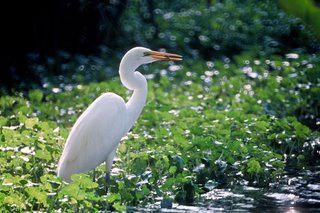 What do you do when one species begins to encroach on the nesting habitat of two at-risk species? That dilemma has faced wildlife officials in Pennsylvania for almost 10 years. This week, the Pennsylvania Game Commission announced its "long-considered, last-resort option" to kill Double-crested Cormorants nesting on Wade Island, an Important Bird Area and a long-time nesting site for Great Egrets (above) and Black-crowned Night-Herons.
What do you do when one species begins to encroach on the nesting habitat of two at-risk species? That dilemma has faced wildlife officials in Pennsylvania for almost 10 years. This week, the Pennsylvania Game Commission announced its "long-considered, last-resort option" to kill Double-crested Cormorants nesting on Wade Island, an Important Bird Area and a long-time nesting site for Great Egrets (above) and Black-crowned Night-Herons."...no other place in the state comes close when comparing the number of nesting sites of these magnificent birds," said Dan Brauning, Game Commission Wildlife Diversity Section supervisor. "Unfortunately, Double-crested Cormorants - also colony nesters - have invaded the night-heron and egret nesting area, and the nesting activity of the cormorants has increasingly become a concern. While cormorants were at one time rare in Pennsylvania, populations have steadily increased since the early 1980s, and they have never been considered a candidate for the state's species of concern list."Brauning said studies show that when nesting cormorants encroach upon colonies of other nesting birds, they reduce the amount of nesting space for those species. Cormorants have been known to take over egret nests and to kill trees as a result of their nesting activity. Several cases found that cormorant droppings on nesting trees apparently caused egrets to abandon colonies.
"In addition to the competition for nesting sites, cormorants also may compete with the herons and egrets for food in the local area around Wade Island," Brauning said. "All three birds feed on fish, and while cormorants usually dive deeper than herons and egrets for their food, scientists believe that the feeding areas of the three species likely overlap in the shallow depths of the Susquehanna River."The commission has worked with USDA Wildlife Services and U.S. Fish & Wildlife Service to plan the culling program.
 City officials have tried to persuade the "Bird Lady" to leave her 25-pound bags of seed at home, but she refuses, leading to lots of refuse for other people to dodge and deal with daily.
City officials have tried to persuade the "Bird Lady" to leave her 25-pound bags of seed at home, but she refuses, leading to lots of refuse for other people to dodge and deal with daily.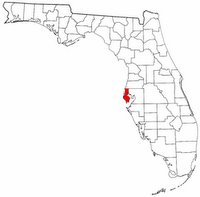 The St. Petersburg-Clearwater area in Florida recently touted itself as a top candidate for the title "Birding Capital of America." Pinellas County apparently sits at the convergence of three zones (temperate, subtropic and Caribbean), and it hosts birds -- more than 365 species -- from all three zones. Among its notable residents and visitors are Least Tern, Merlin, Little Blue Heron, Barred Owl and Black-crowned Night-Heron.
The St. Petersburg-Clearwater area in Florida recently touted itself as a top candidate for the title "Birding Capital of America." Pinellas County apparently sits at the convergence of three zones (temperate, subtropic and Caribbean), and it hosts birds -- more than 365 species -- from all three zones. Among its notable residents and visitors are Least Tern, Merlin, Little Blue Heron, Barred Owl and Black-crowned Night-Heron.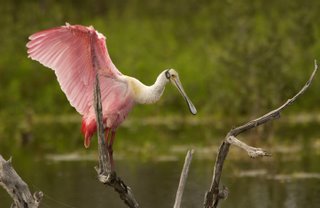 Questions:
Questions: The U.S. Fish & Wildlife Service continually reviews the status of plants and animals on the federal list of endangered and threatened species. The service's Pacific region recently announced its five-year review of 70 species in Idaho, Oregon, Washington, Hawaii and Guam. Six of those species are birds in Hawaii and Guam, such as the Laysan Finch.
The U.S. Fish & Wildlife Service continually reviews the status of plants and animals on the federal list of endangered and threatened species. The service's Pacific region recently announced its five-year review of 70 species in Idaho, Oregon, Washington, Hawaii and Guam. Six of those species are birds in Hawaii and Guam, such as the Laysan Finch.
The subject of conserving rare birds in the wild has long been the focus of research, debate, and action among scientists and resource managers. Recently, there has been growing recognition of diverse avian responses to broad-scale human activities in urban centers, agricultural areas, coastal communities, working forests-the wide array of landscapes we call home. Within these human-dominated systems, shifts are occurring in bird abundance, distribution, behavior, life histories and, ultimately, evolutionary potential. This conference will focus on unique challenges to, and key opportunities for invigorating bird diversity in the areas most heavily impacted by human activities.Click on the link above to see a fantastic Escher print and for registration details.
 This year's recipients include Friends of Little Pend Oreille, a volunteer group that supports Little Pend Oreille National Wildlife Refuge in northeast Washington and plans to build a wheelchair-accessible trail into a refuge that currently lacks designated trails. In southeast Rhode Island, the Norman Bird Sanctuary will use the grant to improve its trails, used by approximately 15,000 visitors each year.
This year's recipients include Friends of Little Pend Oreille, a volunteer group that supports Little Pend Oreille National Wildlife Refuge in northeast Washington and plans to build a wheelchair-accessible trail into a refuge that currently lacks designated trails. In southeast Rhode Island, the Norman Bird Sanctuary will use the grant to improve its trails, used by approximately 15,000 visitors each year.IT'S migration time in Cape May. The birds are converging — millions of them, flapping along their annual routes and propelled by primal urges toward this favored resting spot at the tip of the Jersey Shore.
The birders, too, are following the seasonal imperative, nesting in their habitats of one-story bungalows and gingerbread Victorians. For those lucky enough to own second homes in Cape May, an internationally renowned birding hot spot, the spring approach of the American woodcock and neotropical warblers and all their feathered ilk means the time has come once again to air out the house, tend to the bird-friendly garden and polish up the scopes.
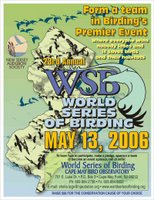 Have you visited Cape May, at the southernmost tip of NooJOYzee? I find it a delightful spot for the birding, the birders and the Victorians. Plus, Bath Time on Jackson Street offers an amazing array of rubber ducks.
Have you visited Cape May, at the southernmost tip of NooJOYzee? I find it a delightful spot for the birding, the birders and the Victorians. Plus, Bath Time on Jackson Street offers an amazing array of rubber ducks.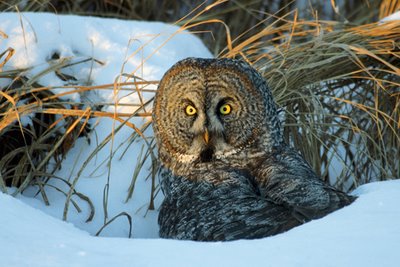 The contest offers five categories (amateur, backyard, digiscoping, flight and water birds), and each category offers first-, second- and third-place prizes including Kowa binoculars, Droll Yankees feeders, Nikon optics, Bushnell binoculars and Leupold & Stevens binoculars. The contest also offers a grand prize: a Canon EOS 20D digital SLR.
The contest offers five categories (amateur, backyard, digiscoping, flight and water birds), and each category offers first-, second- and third-place prizes including Kowa binoculars, Droll Yankees feeders, Nikon optics, Bushnell binoculars and Leupold & Stevens binoculars. The contest also offers a grand prize: a Canon EOS 20D digital SLR.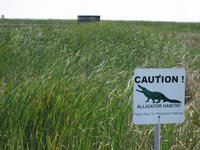 In a comment to a previous post, Leigh Johnson mentioned the big reptile observed during our Birder of the Year trip to south Texas.
In a comment to a previous post, Leigh Johnson mentioned the big reptile observed during our Birder of the Year trip to south Texas. 
 Alabama's Bon Secour National Wildlife Refuge reopened this week. The public can walk its trails for the first time Hurricane Ivan ravaged Fort Morgan Peninsula, Little Dauphin Island and other spots on the Gulf Coast in September 2004.
Alabama's Bon Secour National Wildlife Refuge reopened this week. The public can walk its trails for the first time Hurricane Ivan ravaged Fort Morgan Peninsula, Little Dauphin Island and other spots on the Gulf Coast in September 2004. Grab a cuppa joe, get comfy in your chair, visit this week's I and the Bird carnival, and get ready to be tempted by various books while reading Seth's unique compilation of blog posts.
Grab a cuppa joe, get comfy in your chair, visit this week's I and the Bird carnival, and get ready to be tempted by various books while reading Seth's unique compilation of blog posts.
The mission of The Valley Land Fund, a 501(c)(3) land trust, is to preserve, enhance and expand the native wildlife habitat of the Lower Rio Grande Valley through education, land ownership and the creation of economic incentives for preservation.Next to the airlines' check-in counters, the dozens of images depicted birds, mammals, reptiles and insects. In addition to the great pictures, I enjoyed seeing familiar names among the contest's participating photographers and the promotion of private landowners' role in habitat and wildlife conservation.
The goal of our photo contests is to create a partnership among businesses, private landowners and wildlife photographers, where all participants benefit while promoting the conservation and protection of wildlife and habitat.
Landowners and photographers compete as teams and share equally in the significant prize money. Additionally, they promote wildlife conservation while participating in the most challenging wildlife photo contest in the world.
 Along the trail, Pat heard a Groove-billed Ani, but we didn't see one. We did, however, see or hear White-eyed Vireo and Olive Sparrow before walking next to the Black Vulture roost. It was cool to get such close looks at them.
Along the trail, Pat heard a Groove-billed Ani, but we didn't see one. We did, however, see or hear White-eyed Vireo and Olive Sparrow before walking next to the Black Vulture roost. It was cool to get such close looks at them.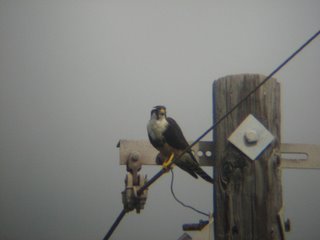 Along the gravel road, Pat stopped when he spied the male Aplomado Falcon on a telephone tower. What a gorgeous raptor! (Please forgive the poor quality of the ad-hoc digiscoped picture.) We all soaked him up through the scope, including Carla. Then someone spotted the female falcon on a nearby tree. Very cool.
Along the gravel road, Pat stopped when he spied the male Aplomado Falcon on a telephone tower. What a gorgeous raptor! (Please forgive the poor quality of the ad-hoc digiscoped picture.) We all soaked him up through the scope, including Carla. Then someone spotted the female falcon on a nearby tree. Very cool.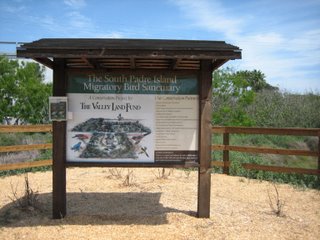 With the caravan winnowed to three cars, we crossed the causeway to South Padre Island and stopped at the entrance to SPI where an American Oystercatcher sat on a nest -- another lifer for Leigh. Pat led us to the island's migratory bird sanctuary, where many birders were enjoying colorful birds. We saw male and female Scarlet Tanagers, male and female Orchard Orioles, Summer Tanager, Ruby-throated Hummingbird, Tennessee Warbler, Rose-breasted Grosbeak (which really impressed Carla), Kentucky Warbler and Indigo Bunting.
With the caravan winnowed to three cars, we crossed the causeway to South Padre Island and stopped at the entrance to SPI where an American Oystercatcher sat on a nest -- another lifer for Leigh. Pat led us to the island's migratory bird sanctuary, where many birders were enjoying colorful birds. We saw male and female Scarlet Tanagers, male and female Orchard Orioles, Summer Tanager, Ruby-throated Hummingbird, Tennessee Warbler, Rose-breasted Grosbeak (which really impressed Carla), Kentucky Warbler and Indigo Bunting.  Along the boardwalks, we enjoyed the sight or sounds of Sora, Great Blue Heron, Red-breasted Merganser, Greater Scaup, Clapper Rail, Osprey, Cattle Egret, Semipalmated Sandpiper and Snowy Egret. It was cool to see Sora (right) in the open and apparently oblivious to us voyeurs. Before climbing into our cars, we saw Red-eyed Vireo, White-tailed Kite and Scarlet Tanager.
Along the boardwalks, we enjoyed the sight or sounds of Sora, Great Blue Heron, Red-breasted Merganser, Greater Scaup, Clapper Rail, Osprey, Cattle Egret, Semipalmated Sandpiper and Snowy Egret. It was cool to see Sora (right) in the open and apparently oblivious to us voyeurs. Before climbing into our cars, we saw Red-eyed Vireo, White-tailed Kite and Scarlet Tanager. Martin spotted four Mississippi Kites perched in a tall, bare tree. They remained oblivious to us, and we enjoyed many looks from different points before they flew. Such beautiful gray birds of prey.
Martin spotted four Mississippi Kites perched in a tall, bare tree. They remained oblivious to us, and we enjoyed many looks from different points before they flew. Such beautiful gray birds of prey. On the walk toward the hawk watch, we saw two Scissor-tailed Flycatchers, male and female on the telephone wire, giving us a chance to see the difference in tail length. An Altamira Oriole blazed across the gravel road leading to the hawk watch. There, we enjoyed the dozens and dozens of TVs and Swainson's overhead before meeting up with Carla and beginning the drive up river.
On the walk toward the hawk watch, we saw two Scissor-tailed Flycatchers, male and female on the telephone wire, giving us a chance to see the difference in tail length. An Altamira Oriole blazed across the gravel road leading to the hawk watch. There, we enjoyed the dozens and dozens of TVs and Swainson's overhead before meeting up with Carla and beginning the drive up river. The birds really made us wait for 'em, but we saw Osprey, Pied-billed Grebe, a familiar subspecies of Anas rubberii, American Coot, Great Blue Heron, Common Moorhen and Purple Martin. The latter flew close to the river's surface and quickly dipped its chest into the water repeatedly; Leigh said it's a cooling technique used by nesting birds.
The birds really made us wait for 'em, but we saw Osprey, Pied-billed Grebe, a familiar subspecies of Anas rubberii, American Coot, Great Blue Heron, Common Moorhen and Purple Martin. The latter flew close to the river's surface and quickly dipped its chest into the water repeatedly; Leigh said it's a cooling technique used by nesting birds. A quick stop at Salineno revealed few birds, notably our first Northern Cardinals of the trip. Then Sheridan and Martin departed for home, while our trio departed for sustenance. We found cool refreshments at the "Texas stop sign," where the Birder of the Year enjoyed her first Blizzard ever.
A quick stop at Salineno revealed few birds, notably our first Northern Cardinals of the trip. Then Sheridan and Martin departed for home, while our trio departed for sustenance. We found cool refreshments at the "Texas stop sign," where the Birder of the Year enjoyed her first Blizzard ever. After a bit of a trek east and south, we found Vieh's Bed & Breakfast in San Benito right where Lana said it would be: to the right of the big white mailbox. We also found dozens of Black-bellied Whistling-Ducks perched in the trees and on the house's roof. Charlie provides nestboxes for the squeaky-sounding ducks, and they provide lots of entertainment.
After a bit of a trek east and south, we found Vieh's Bed & Breakfast in San Benito right where Lana said it would be: to the right of the big white mailbox. We also found dozens of Black-bellied Whistling-Ducks perched in the trees and on the house's roof. Charlie provides nestboxes for the squeaky-sounding ducks, and they provide lots of entertainment.
 We saw and heard lots of great birds, including Northern Parula, Golden-fronted Woodpecker and Black-bellied Whistling-Duck. The latter species amused me and Leigh with the squeaky call, and we saw lots of them, including five perched in the same bare tree.
We saw and heard lots of great birds, including Northern Parula, Golden-fronted Woodpecker and Black-bellied Whistling-Duck. The latter species amused me and Leigh with the squeaky call, and we saw lots of them, including five perched in the same bare tree. At a platform feeder, we enjoyed Indigo Bunting, Long-billed Thrasher, Altamira/Audubon’s Oriole hybrid and Great-tailed Grackle. At another observation blind (very nicely designed, by the way), we observed Green Jay, Red-winged Blackbird and a javelina eating refuse from a suspended seed feeder. Then, finally, Leigh saw her life Plain Chachalaca.
At a platform feeder, we enjoyed Indigo Bunting, Long-billed Thrasher, Altamira/Audubon’s Oriole hybrid and Great-tailed Grackle. At another observation blind (very nicely designed, by the way), we observed Green Jay, Red-winged Blackbird and a javelina eating refuse from a suspended seed feeder. Then, finally, Leigh saw her life Plain Chachalaca. 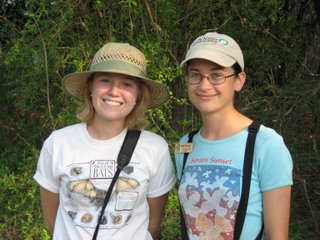 Heidi (on the right) lead the way to a guaranteed spot for Buff-bellied Hummingbird – a coworker’s trailer. We oozed into the lawn chairs and chatted while waiting for the beautiful bird to visit the sugar-water feeder, which it did about four times. The buff-belly provided a fine finish to a day with more than 25 life birds for Leigh.
Heidi (on the right) lead the way to a guaranteed spot for Buff-bellied Hummingbird – a coworker’s trailer. We oozed into the lawn chairs and chatted while waiting for the beautiful bird to visit the sugar-water feeder, which it did about four times. The buff-belly provided a fine finish to a day with more than 25 life birds for Leigh.
 We met up with Sheridan Coffey and Martin Reid, also staying at the inn, for dinner. Following our arduous hike across the street to El Dorado, we gratefully downed the hee-YUGE glasses of beverages. The waiter later delivered hee-YUGE platters of tasty and filling Tex-Mex vittles, which we enjoyed amid laughter-accented conversation.
We met up with Sheridan Coffey and Martin Reid, also staying at the inn, for dinner. Following our arduous hike across the street to El Dorado, we gratefully downed the hee-YUGE glasses of beverages. The waiter later delivered hee-YUGE platters of tasty and filling Tex-Mex vittles, which we enjoyed amid laughter-accented conversation.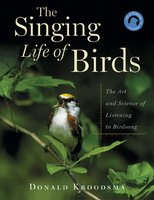 Birdsong appears to have become a popular book topic within the last 10 years and particularly in the last two. Last year, Donald Kroodsma's The Singing Life of Birds: The Art and Science of Listening to Birdsong emerged, with CD and sonagrams.
Birdsong appears to have become a popular book topic within the last 10 years and particularly in the last two. Last year, Donald Kroodsma's The Singing Life of Birds: The Art and Science of Listening to Birdsong emerged, with CD and sonagrams. Careful readers will note that the guy who "won" was hardly a shining example of birding ethics. What kind of person would pay thousands of dollars for flights and car rentals to chase a rare bird and then try to avoid paying a couple of bucks to get into a state park? Real birders carry their share, do their part, try to support the resource that supports their birding. (emphasis mine--ah)We can do our part to protect the habitat that supports "our" birds by paying just $15 for a stamp that provides free access to all NWRs and purchases more habitat.
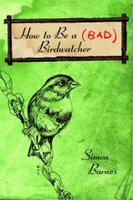 Have your eyes feasted on Simon Barnes' How to be a (Bad) Birdwatcher? I thoroughly enjoyed the advance reader's edition sent to the office last year and continually indulge in tidbits during the lunch hour.
Have your eyes feasted on Simon Barnes' How to be a (Bad) Birdwatcher? I thoroughly enjoyed the advance reader's edition sent to the office last year and continually indulge in tidbits during the lunch hour.The most popular activity in the industrialized part of the world is going for a walk in the country, and it's about the best, too. Something deep inside propels us outside, to move about anywhere that's a bit green: city park, suburban open space, wilderness. And here's how you do it. You put one foot after another, and when you see a bird, you stop and put your binoculars to your eyes and say, "What the bloody hell's that?"and
I already had a pair of binoculars, the ones I got for horse racing. They cost HK$100, or about ten quid; not a lot, even then. They were, in snobbish birdwatching terms, or even in ordinary optical terms, complete crap. But even the crappiest binoculars are great. My binoculars were utterly brilliant. They brought the birds closer, you see.and finally
The only real skill involved in this perfect birdwatching moment was the willingness to look. It was not skill that gave me the sight; it was habit. I have developed the habit of looking: when I see a bird, I always look, wherever I am. It is no longer a conscious decision. I might be in the middle of a conversation of amazing importance about the Direction of Our Marriage, but my eye will flick out of the window at a hint of movement, caught in the tail of my eye, and I will register: bloody hell, sparrowhawk. I might say it aloud, too--not necessarily a wise decision.Barnes' not-so-serious perspective echoes that of Pete Dunne in his recent article about the 20 biggest changes in birding in the last 20 or so years. In the March/April issue, Dunne finished the piece with
No matter how experienced we grow, no matter how sophisticated our avocation becomes, fun always should lie at the heart of birding. If you look at the very finest birders in North American, you will note that they embody this simple truth.Do you know of a book or a birder who embodies this truth? Please share in the comments.
The dinosaur had a strong toothless beak, powerful arms and formidable claws that made it capable of eating animals and plants. Large feathers grew on its hind end, giving it a resemblance to a turkey, [doctoral student Lindsay] Zanno said.You can watch a video report here.
Scientists are not sure what purpose the feathers served, but it was not for flying. "It's quite different from modern birds," she said.
 That point received reinforcement at the end of videographer David Luneau's presentation. He closed his remarks by pointing out the duckhunting community's role in the conservation and search-and-recovery efforts. (Luneau later added that he does not hunt ducks.)
That point received reinforcement at the end of videographer David Luneau's presentation. He closed his remarks by pointing out the duckhunting community's role in the conservation and search-and-recovery efforts. (Luneau later added that he does not hunt ducks.) Myriad bird species and other wildlife live within those 5.2 million acres. Those animals likely wouldn't be protected within that land if not for the Duck Stamp.
Myriad bird species and other wildlife live within those 5.2 million acres. Those animals likely wouldn't be protected within that land if not for the Duck Stamp.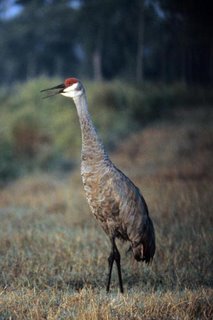 for pointing out this well-done article in USA Today about Sandhill Cranes.
for pointing out this well-done article in USA Today about Sandhill Cranes.  The egrets in the Bellagio's conservatory also struck poses for their many admirers.
The egrets in the Bellagio's conservatory also struck poses for their many admirers.